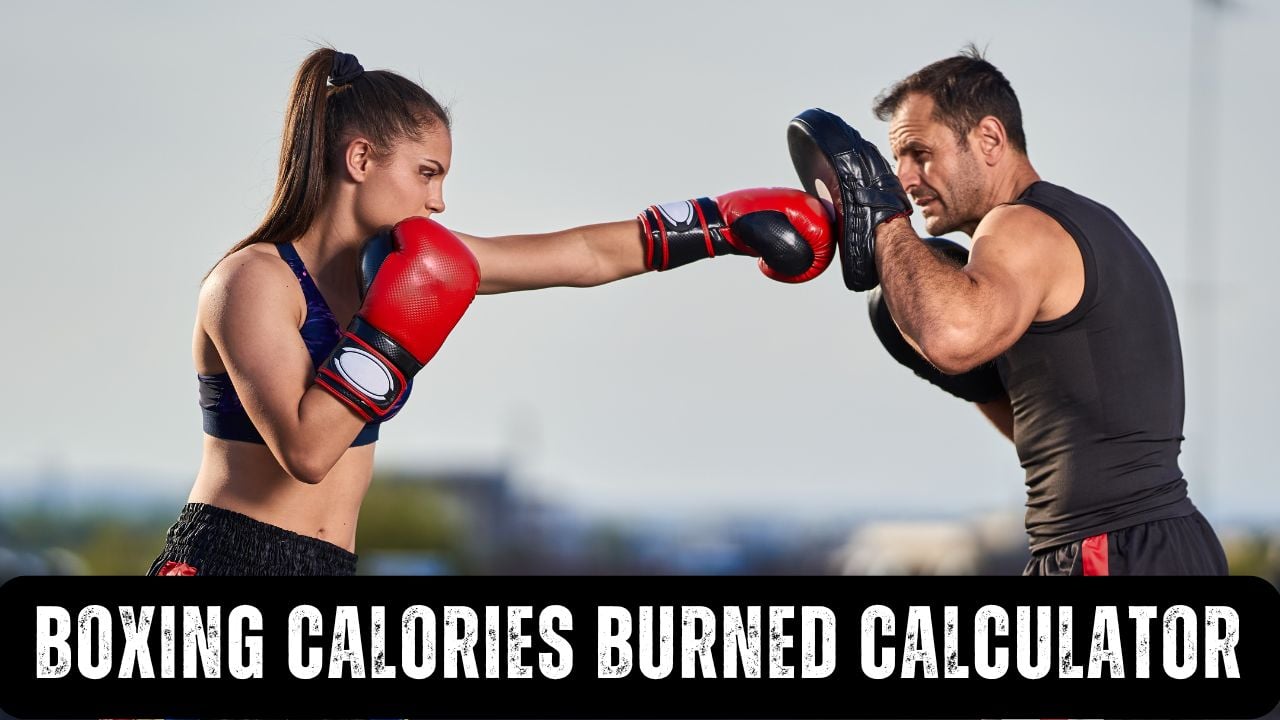Boxing Calories Burned Calculator

How Many Calories Does Boxing Burn?
Boxing burns between 400-900 calories per hour depending on activity type, intensity, and body weight. A typical 60-minute boxing training session burns 550-750 calories for most people.
As a combat sport, boxing combines high-intensity cardio, power development, and full-body conditioning. The interval nature alternates between explosive striking and active recovery, creating an effective metabolic training environment.
Research confirms that boxing’s combination of high-intensity intervals and full-body engagement creates one of the most effective calorie-burning environments in sports. For comprehensive cardio comparison, explore our exercise calorie calculator to see how boxing compares to other workouts.
The Science Behind Boxing Calorie Burn
Understanding Each Component:
- Time: Duration of your boxing training in minutes
- MET Value: Metabolic Equivalent of Task (5.5-12.3 for different boxing activities)
- 3.5: Standard oxygen consumption constant (ml/kg/min at rest)
- Weight: Your body weight in kilograms
- 200: Conversion factor to calculate calories
💡 Practical Example:
Person: 75 kg (165 lbs)
Duration: 60 minutes
Activity: Punching Bag – Vigorous (8.5 METs)
Calculation:
(60 × 8.5 × 3.5 × 75) ÷ 200 = 669 calories
🥊 Understanding MET Values for Boxing
MET (Metabolic Equivalent of Task) values represent exercise intensity compared to resting metabolism. The Compendium of Physical Activities provides validated MET values for various boxing activities:
Shadow Boxing (5.5 METs): Technique practice with no resistance, focusing on form and movement patterns.
Punching Bag – General (5.8 METs): Light work on heavy bag, basic combinations at low intensity.
Punching Bag – Moderate (7.0 METs): Approximately 60 punches per minute with moderate power.
Punching Bag – Vigorous (8.5 METs): Around 120 punches per minute with increased power output.
Punching Bag – High Intensity (10.8 METs): Approximately 180 punches per minute, maximum effort.
Sparring (7.8 METs): Practice rounds with controlled contact, defensive movement included.
Simulated Boxing Round (9.3 METs): Exercise drill mimicking competition rounds without contact.
Boxing In Ring – General (12.3 METs): Competition-level boxing with full intensity and tactical demands.
🎯 Factors Affecting Boxing Calorie Burn
Multiple factors influence your boxing calorie expenditure:
Body Weight: Heavier individuals burn more calories performing the same movements. A 20 kg (44 lb) weight difference can change calorie burn by 25-30%.
Punch Frequency: More punches per minute dramatically increases energy expenditure. High-volume training can double calorie burn compared to technical work.
Experience Level: Beginners may burn slightly more calories due to less efficient movement, but advanced boxers can sustain higher intensity longer.
Movement Quality: Proper footwork, defensive slips, and head movement add significant energy cost beyond just punching.
Training Type: Different boxing activities have different MET values based on intensity patterns and work-to-rest ratios.
Boxing Calorie Burn by Activity Type
| Boxing Activity | MET Value | Intensity Level | Calories/Hour (75kg) | Training Focus |
|---|---|---|---|---|
| Shadow Boxing | 5.5 | Light-Moderate | 433 cal/hr | Technique, form |
| Punching Bag – General | 5.8 | Moderate | 457 cal/hr | Basic combinations |
| Punching Bag – Moderate | 7.0 | Moderate | 551 cal/hr | 60 punches/min |
| Sparring | 7.8 | Moderate-Vigorous | 614 cal/hr | Practice rounds |
| Punching Bag – Vigorous | 8.5 | Vigorous | 669 cal/hr | 120 punches/min |
| Simulated Round | 9.3 | Vigorous-High | 732 cal/hr | Competition drill |
| Punching Bag – High Intensity | 10.8 | High | 851 cal/hr | 180 punches/min |
| Boxing In Ring | 12.3 | Maximum | 969 cal/hr | Competition |
Note: Values shown for a 75 kg (165 lb) person. Actual calorie burn varies with body weight, movement intensity, and individual technique efficiency. Values based on Compendium of Physical Activities research.
Boxing Calories Burned by Duration
⏱️ Time-Based Calorie Estimates
Understanding how duration affects total calorie burn helps you plan effective boxing sessions for weight management and fitness goals. These estimates are based on punching bag work at vigorous intensity (8.5 METs).
For comprehensive calorie tracking, explore our BMR calculator to understand your daily caloric needs and TDEE calculator for complete metabolic analysis.
| Duration | 130 lb (59 kg) | 150 lb (68 kg) | 175 lb (79 kg) | 200 lb (91 kg) | 225 lb (102 kg) | 250 lb (113 kg) |
|---|---|---|---|---|---|---|
| 15 mins | 132 cal | 152 cal | 177 cal | 203 cal | 228 cal | 252 cal |
| 30 mins | 263 cal | 304 cal | 353 cal | 407 cal | 456 cal | 505 cal |
| 45 mins | 395 cal | 455 cal | 530 cal | 610 cal | 683 cal | 757 cal |
| 60 mins | 527 cal | 607 cal | 706 cal | 813 cal | 911 cal | 1010 cal |
| 90 mins | 790 cal | 911 cal | 1059 cal | 1219 cal | 1367 cal | 1514 cal |
Note: Values based on punching bag – vigorous intensity (8.5 METs). Higher intensity activities like sparring or competition can increase these values by 15-40%.
Boxing Training Tips for Maximum Calorie Burn
🥊 High-Intensity Training Techniques
Interval Training: Alternate between high-intensity rounds (2-3 minutes) and active recovery (1 minute). This mimics competition structure and maximizes calorie burn through EPOC (Excess Post-exercise Oxygen Consumption).
Combination Drills: Practice complex punch combinations that engage your entire body. Multi-punch sequences increase movement volume and energy expenditure compared to single punches.
Footwork Integration: Add defensive slips, pivots, and lateral movement to your bag work. Footwork can increase calorie burn by 20-30% compared to static punching.
💪 Proper Technique for Sustained Performance
Form First: Proper punching technique reduces injury risk and allows you to sustain higher intensity longer. Good form means more total work and greater calorie expenditure over your training session.
Breathing Control: Exhale sharply with each punch to maintain oxygen supply and prevent early fatigue. Proper breathing supports longer, more intense training sessions.
Progressive Overload: Gradually increase punch volume, round duration, or intensity. Track your progress using our calculator to monitor improvements in calorie burn capacity.
🎯 Supporting Your Boxing Performance
Strength Training: Build punching power and endurance with compound movements. Leg exercises improve footwork and power transfer from the ground up.
Core Development: A strong core is essential for punch power and defensive movement. Core strengthening exercises complement boxing training perfectly.
Cardiovascular Base: Build your aerobic capacity with supplementary cardio. Compare with our running calculator and cycling calculator for cross-training options.
Boxing Calorie Calculator FAQs
❓ How accurate is the boxing calorie calculator?
Our calculator uses the scientifically validated formula: Calories = (Time × MET × 3.5 × Weight) ÷ 200, combined with research-based MET values from the Compendium of Physical Activities. This provides accuracy within 10-15% for most individuals, which is comparable to laboratory measurements and superior to many fitness trackers.
🥊 Which boxing activity burns the most calories?
Boxing in the ring during competition (12.3 METs) burns the most calories, typically 800-1000+ calories per hour for a 75 kg person. High-intensity punching bag work (10.8 METs) and simulated rounds (9.3 METs) also provide excellent calorie burn at 700-900 calories per hour.
⏱️ How long should I box to lose weight?
For weight loss, aim for 45-60 minute boxing sessions 3-4 times per week, combined with proper nutrition creating a calorie deficit. A 60-minute vigorous session burning 500-700 calories contributes significantly to the 3,500 calorie deficit needed to lose one pound of fat. Consistency over weeks and months is key for sustainable results.
🏃 How does boxing compare to running?
Boxing typically burns similar or more calories than running (500-700 cal/hour vs 400-600 cal/hour for moderate jogging) while offering upper body development and skill acquisition that running doesn’t provide. Boxing’s interval nature also creates greater EPOC (afterburn effect) compared to steady-state cardio.
👊 Is punching bag work as effective as sparring?
Vigorous punching bag work (8.5 METs) can actually burn more calories than light sparring (7.8 METs) because you can maintain higher intensity without the tactical breaks required in sparring. However, sparring develops additional skills and includes defensive movement that adds training value beyond calorie burn.
💪 Why does punch frequency affect calorie burn?
Higher punch frequency dramatically increases energy expenditure because each punch requires full-body coordination from legs through core to arms. The MET value increases from 7.0 METs at 60 punches/minute to 10.8 METs at 180 punches/minute – a 54% increase in calorie burn from punch volume alone.
🥊 Safety & Training Disclaimer
This boxing calorie calculator provides estimates based on scientific formulas and should not replace professional coaching advice or medical guidance. Calorie estimates are most accurate when combined with comprehensive fitness assessments. Individual results vary due to technique, intensity, fitness level, and metabolic factors. Boxing is a physically demanding combat sport that carries inherent risks. Always train with proper supervision, especially for sparring or competitive work. Use appropriate protective equipment including hand wraps, gloves, and mouthguard. Consult with healthcare professionals, certified boxing coaches, or sports medicine specialists before beginning boxing training, especially if you have pre-existing health conditions, joint issues, or cardiovascular concerns. This tool is for educational and informational purposes only.
References
- Conger SA, Herrmann SD, Willis EA, Nightingale TE, Sherman JR, Ainsworth BE. 2024 Wheelchair Compendium of Physical Activities: An update of activity codes and energy expenditure values. Journal of Sport and Health Science, 2024;13(1): 18-23.
- Herrmann SD, Willis EA, Ainsworth BE, Barreira TV, Hastert M, Kracht CL, Schuna Jr. JM, Cai Z, Quan M, Tudor-Locke C, Whitt-Glover MC, Jacobs DR. 2024 Adult Compendium of Physical Activities: A third update of the energy costs of human activities. Journal of Sport and Health Science, 2024;13(1): 6-12.
- Bozdarov, J., M Jones, B. D., Daskalakis, Z. J., & Husain, M. I. (2022). Boxing as an Intervention in Mental Health: A Scoping Review. American Journal of Lifestyle Medicine, 17(4), 589. https://doi.org/10.1177/15598276221124095
- EL Ashker, Said. (2018). The impact of a boxing training program on physical fitness and technical performance effectiveness. Journal of Physical Education and Sport. 18. 10.7752/jpes.2018.02137.

Manish is a NASM-certified fitness and nutrition coach with over 10 years of experience in weight lifting and fat loss fitness coaching. He specializes in gym-based training and has a lot of knowledge about exercise, lifting technique, biomechanics, and more.
Through “Fit Life Regime,” he generously shares the insights he’s gained over a decade in the field. His goal is to equip others with the knowledge to start their own fitness journey.
